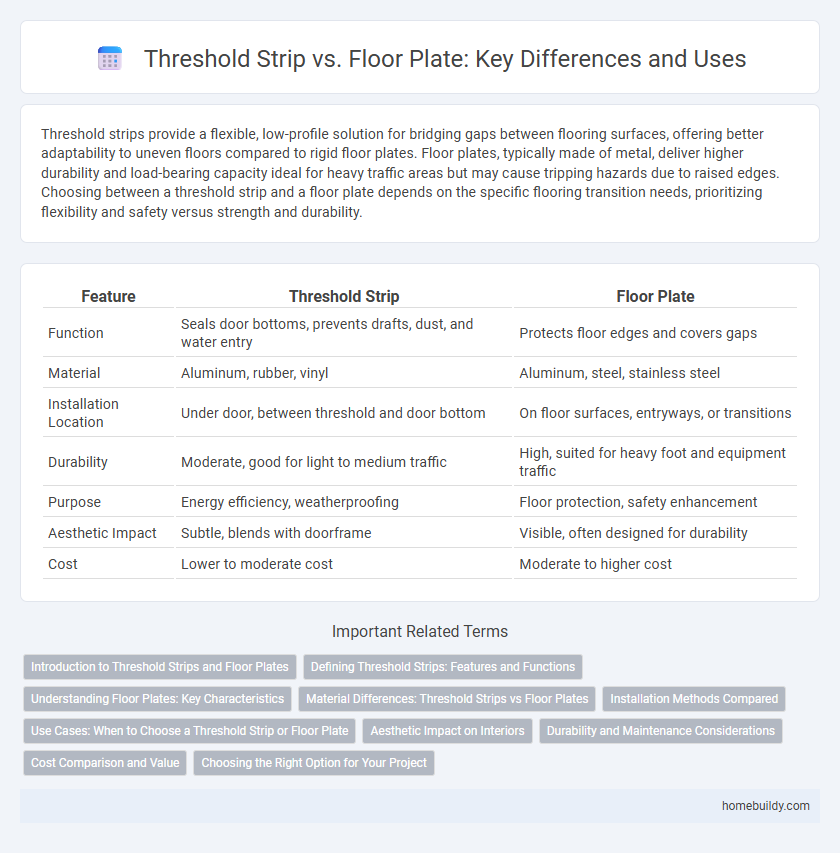Threshold strips provide a flexible, low-profile solution for bridging gaps between flooring surfaces, offering better adaptability to uneven floors compared to rigid floor plates. Floor plates, typically made of metal, deliver higher durability and load-bearing capacity ideal for heavy traffic areas but may cause tripping hazards due to raised edges. Choosing between a threshold strip and a floor plate depends on the specific flooring transition needs, prioritizing flexibility and safety versus strength and durability.
Table of Comparison
| Feature | Threshold Strip | Floor Plate |
|---|---|---|
| Function | Seals door bottoms, prevents drafts, dust, and water entry | Protects floor edges and covers gaps |
| Material | Aluminum, rubber, vinyl | Aluminum, steel, stainless steel |
| Installation Location | Under door, between threshold and door bottom | On floor surfaces, entryways, or transitions |
| Durability | Moderate, good for light to medium traffic | High, suited for heavy foot and equipment traffic |
| Purpose | Energy efficiency, weatherproofing | Floor protection, safety enhancement |
| Aesthetic Impact | Subtle, blends with doorframe | Visible, often designed for durability |
| Cost | Lower to moderate cost | Moderate to higher cost |
Introduction to Threshold Strips and Floor Plates
Threshold strips create a seamless transition between different flooring surfaces by covering gaps and providing durability at doorways. Floor plates are typically metal coverings that protect floor openings or wiring channels, offering robust protection rather than aesthetic transition. Both components enhance safety and functionality, with threshold strips focusing on smooth passage and floor plates emphasizing structural protection.
Defining Threshold Strips: Features and Functions
Threshold strips are narrow, elongated profiles designed to cover the joint or uneven surface between two flooring materials, providing a smooth and safe transition. These strips feature durable materials such as aluminum or rubber, with anti-slip surfaces to enhance safety and prevent tripping hazards. Their primary function includes sealing gaps to prevent drafts, moisture, and dust infiltration while accommodating slight floor height differences.
Understanding Floor Plates: Key Characteristics
Floor plates are flat, durable panels typically made from metal or composite materials designed to cover or protect floor openings and transitions. Unlike threshold strips, which primarily focus on sealing gaps and providing a smooth transition between different flooring types, floor plates offer enhanced structural support and resistance to heavy traffic or impact. Their key characteristics include high load-bearing capacity, slip resistance, and corrosion-resistant finishes suitable for industrial and commercial environments.
Material Differences: Threshold Strips vs Floor Plates
Threshold strips are typically made from flexible materials such as rubber, vinyl, or aluminum, designed to provide a smooth transition between different floor surfaces while offering water resistance and sound insulation. In contrast, floor plates are commonly constructed from heavy-duty metals like steel or aluminum, emphasizing durability and load-bearing capacity in industrial or high-traffic areas. The material choice directly influences the application, with threshold strips prioritizing comfort and sealing properties, whereas floor plates focus on strength and protection.
Installation Methods Compared
Threshold strips typically require surface mounting with screws or adhesive, allowing for straightforward installation on various floor types. Floor plates often involve recessed installation, necessitating cutting or routing the floor surface to create a flush fit. Installation of threshold strips generally demands less floor modification and quicker setup than floor plates, which require more precise labor and tools.
Use Cases: When to Choose a Threshold Strip or Floor Plate
Threshold strips are ideal for sealing door gaps and providing smooth transitions between different flooring types, enhancing energy efficiency and preventing drafts, moisture, and insects. Floor plates suit high-traffic industrial or commercial areas, offering durable protection over cable runs and uneven surfaces while maintaining safety by reducing trip hazards. Choose a threshold strip for residential or light commercial doorways, and opt for a floor plate when heavy equipment, cables, or frequent foot traffic demand robust, impact-resistant coverage.
Aesthetic Impact on Interiors
Threshold strips provide a seamless transition between rooms with minimal visual disruption, often designed to blend with various flooring materials for a sleek, cohesive look. Floor plates tend to be bulkier and more noticeable, which can detract from the aesthetic flow of interiors, especially in high-end or modern design settings. Selecting a threshold strip enhances interior aesthetics by maintaining clean lines and a subtle finish that complements the overall decor.
Durability and Maintenance Considerations
Threshold strips offer superior durability compared to floor plates, as they are typically crafted from robust materials like aluminum or rubber designed to withstand heavy foot traffic and environmental wear. Maintenance is generally simpler with threshold strips due to their fixed position and resistance to corrosion, whereas floor plates often require frequent cleaning and tightening to prevent loosening or damage. The reduced need for repairs and the enhanced longevity of threshold strips make them a practical choice for long-term floor transition solutions.
Cost Comparison and Value
Threshold strips typically offer a more cost-effective solution compared to floor plates, with prices often ranging from $10 to $30 per strip versus $50 to $100 or more for floor plates. While floor plates provide higher durability and heavy-duty protection, threshold strips deliver excellent value for standard residential or commercial applications where budget is a primary concern. Evaluating long-term maintenance and installation costs, threshold strips generally yield better overall value for everyday use despite floor plates' superior toughness.
Choosing the Right Option for Your Project
Threshold strips provide a flexible, low-profile solution ideal for sealing gaps and minimizing drafts between rooms, often preferred for residential settings due to easy installation and aesthetics. Floor plates, made of durable metal or heavy-duty materials, offer robust protection for high-traffic areas or commercial projects requiring superior wear resistance and load-bearing capacity. Selecting the right option depends on factors like traffic intensity, material durability, weather sealing needs, and installation environment to ensure optimal performance and longevity.
Threshold strip vs Floor plate Infographic

 homebuildy.com
homebuildy.com